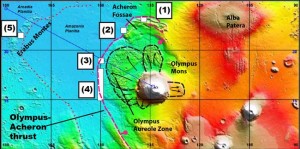 Wow … cool … space.com reports that there is evidence that there has been plate tectonic activity on Mars as recently as 250,000 years ago.
Wow … cool … space.com reports that there is evidence that there has been plate tectonic activity on Mars as recently as 250,000 years ago.
You can click on the picture to get a larger copy.
What it shows is that the many ridges and scarps on the rumpled apron of land north and west of Olympus Mons are likely signs of tectonic thrusting, according to the study it might have been recent.
Ohhh … sanity alert … take with a grain of salt please, there is a high degree of fuzziness in the study and this has yet to be confirmed. In essence what this means is that somebody has looked at some data and come up with a hypothesis to explain it.
So, why is this a big deal, well as space.com puts it …
If the study’s conclusions are confirmed, they would overturn conventional wisdom, which holds that plate tectonic forces are unlikely to have played a major role in shaping the surface of Mars — particularly in the recent past.
“People don’t want there to be plate tectonics on Mars,” said study author An Yin of UCLA, who presented his findings in December at the fall 2010 meeting of the American Geophysical Union in San Francisco. “But I think there’s good evidence for it.”
The thinking up to now is that Mars is too small, and its interior is too cold, for plate tectonics, so if this turns out not to be correct and it really has been happening, then the chances of life on Mars has just been greatly increased because it brings carbon and other substances from the Martian interior up to the surface.
So just how compelling is the evidence?
Yin acknowledges that his views lie outside the mainstream scientific view. He may bring a different perspective to Martian geology than most scientists because he has spent most of his career studying landforms and processes on Earth.
“I’m way out there,” he said. “I’m new to this field, but I’ve been working on Earth geology for 30 years.”
The landforms on Olympus Mons’ northwest flank are not the only argument for tectonic activity on Mars. Other researchers have pointed out that the Red Planet has several long, relatively straight chains of volcanoes — including three volcanoes that make up the Tharsis Montes, near Olympus Mons.
These features are tough to explain, but plate tectonics can do the job, Yin said. The volcano chains could have formed from the motion of a crustal plate sitting over a “hot spot” in the mantle, just as the Hawaiian Islands are thought to have formed on Earth.
OK, so its not an air-tight case yet, but its all still fascinating and very compelling.
Great site. A lot of useful information here. I’m sending it to some friends!